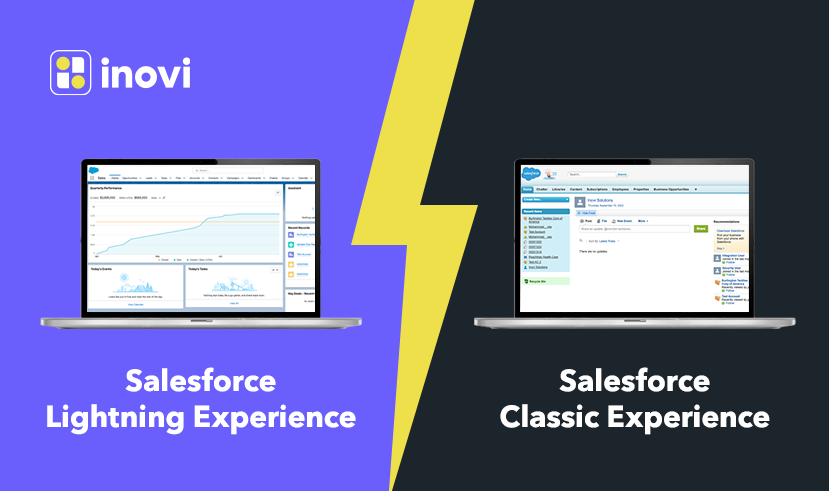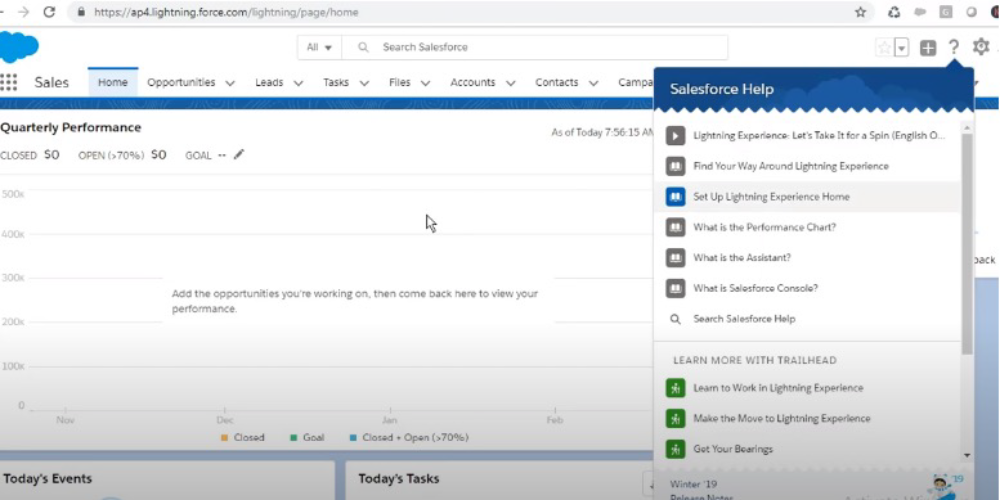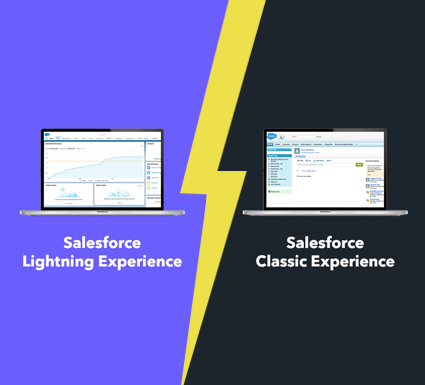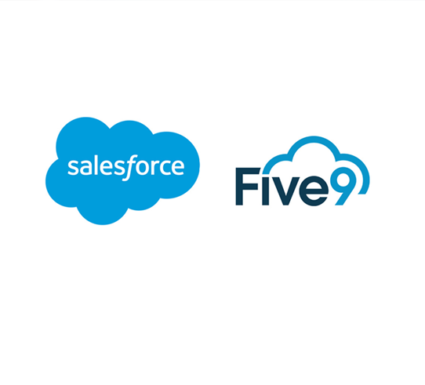Salesforce Lightning vs. Classic (Compared by Experts)
Not sure whether you should switch to the new Lightning experience? Check out this comparison of Salesforce Lightning vs. Classic from the experts.

Salesforce Lightning vs. Classic — which is the better choice for your business? Many businesses and IT leaders aren’t sure which to use when considering an upgrade or new migration and implementation of Salesforce. There are many factors to consider when making this decision such as cost, features, and your team’s unique needs.
In this article, we will compare the pros and cons, and essential features of Salesforce Lightning and Classic to help you determine which is best for your growing business.
What is Salesforce Lightning?
Salesforce Lightning is a new user interface (UI) for Salesforce. It is designed to be faster, easier to use, and more mobile-friendly than Salesforce Classic.
Also, Lightning comes with several new features that are not available in Classic, such as Lightning Components, Lightning Process Builder, Lightning Flow, an activity timeline and workplace page layouts.
Salesforce has made it clear that Lightning is the future of their enterprise and eventually all businesses will migrate from Salesforce Classic to Salesforce Lightning. They also offer extensive training modules to help new users learn how to use Salesforce Lightning through their free Trailhead learning and development platform.
However, it is essential to understand that Lightning is still in its early stages of development and enhancement, and some features are not yet available in Lightning.
For example, if your business uses Visualforce pages, you will not be able to use them in Lightning just yet. If those are essential to your business, it may be too early for your company to adopt Salesforce Lightning.

Features of Salesforce Lightning
Salesforce created Salesforce Lightning to make the platform more approachable and user-friendly for companies and users who don’t have programming experience. It was meant to allow people to “do-it-yourself” so they can use and configure more features and settings without deep technological knowledge.
Salesforce Lightning uses a component-based framework for app development to simplify processes for business users.
Lightning was created to integrate more seamlessly with Einstein AI so people can use more Einstein AI features like automated contacts, opportunity insights, and forecasting.
Some important features of Salesforce Lightning include:
Lightning Components
Salesforce Lightning Components are reusable building blocks that you can use to create custom applications in Lightning and do more simple development tasks yourself, even if you don’t have programming experience.
Lightning App Builder
One major benefit of Salesforce Lightning is the App Builder tool, which is a point-and-click function that you can use to build custom Lightning apps without knowing how to code.
Drag-and-Drop Builder
The Salesforce Lightning Drag-and-Drop Builder makes it easy to create pages and components without code.
Mobile-Friendly
Salesforce recognized years ago that we are increasingly mobile, and need to be able to access our customer and operational data 24/7 from any device. Lightning is designed to be used on mobile devices, so it has a simplified layout and smaller screen real estate to mimic the functionality of using Salesforce Classic on a desktop.
Advanced Search
Lightning offers an advanced search feature that makes it easy to find the information you need.
Advantages of Using Salesforce Lightning
Salesforce Lightning offers numerous advantages for businesses who have a mobile or remote workforce, and it’s a great option for businesses who haven’t yet migrated to the Salesforce platform. Doing a new Salesforce implementation right into the Lightning org will help future-proof your operations because employees and users will only need to be trained once on how to use Salesforce Lightning.
Some other benefits of Salesforce Lightning are that it’s faster and easier to use for many people, especially digital natives such as Millennials and Generation Z workers who can intuitively learn new apps quickly. Salesforce Lightning has a modern user interface (UI) and is being continuously updated and developed by Salesforce, and it is clearly the platform of choice for the future.
Lightning also has a lower total cost of ownership (TCO) over the long run because more of your employees will be able to do-it-yourself and create functionality or components without needing developer support.
Lightning has enhanced security features to minimize the chances of phishing, malware and other vulnerabilities, and Salesforce offers multi-factor authentication, encryption, event monitoring, audits and other sophisticated security features to prevent bad actors from accessing your org.
What if I Already Use Salesforce Classic?
Salesforce Classic is the standard user interface for Salesforce, and many current Salesforce customers rely on Classic to run their businesses.
Classic is the original user interface for Salesforce that has been around the longest, and most users were trained on Classic and feel comfortable using Classic.
Salesforce is committed to continuing to support and develop Classic, and many functions within Classic are also compatible or available in the new Lightning interface as well.
Over time as Lightning becomes more fully developed and has completely replicated all of the Classic features, more businesses will likely migrate away from Classic in favor of the more nimble and easy-to-use Lightning.
Features of Salesforce Classic
Businesses that use Classic appreciate the deep functionality that their users as well as developers and coders are familiar with. Some of the most popular features of Salesforce Classic include:
Customizable Page Layouts
You can customize the page layout for each object in Salesforce Classic to display the most important fields to your users.
For example, some sales teams may want to see the department, group or function of a contact displayed before seeing that person’s phone number or email address. Other teams may want to see the physical location of a contact before seeing their title or contact information.
Visualforce Pages
Visualforce pages in Salesforce Classic allow you to build custom pages using HTML, CSS, and Apex code. Visualforce pages are essential building blocks for application developers because they have important features to access, display, and update your organization’s data. Pages can have a unique URL, just like they would have on a traditional web server.
Custom Objects
Custom objects allow you to create new objects to store and organize data that’s specific to your business. Salesforce Classic allows companies to create numerous custom objects that meet their exact business needs, and this ability is one of the top reasons many businesses migrate to the world’s #1 CRM in the first place.
Some businesses may want to track unique customer data such as how many days between certain meetings or approvals in the sales pipeline, or how many customers did an upgrade when they renewed their contract.
It’s easy to create custom objects in Salesforce Classic, and the wizard helps you easily complete the setup for each custom object field your business needs.
Reports and Dashboards
To make more informed decisions, Salesforce Classic offers a wide variety of reports and dashboards to access your data. There are also countless ways to create custom reports and dashboards to gain better insights on critical business efforts such as attendance at conferences, training and development programs, the effectiveness of e-mail marketing campaigns and other activities.
Activity Timeline
The activity timeline in Salesforce Classic displays all of an object’s activities in chronological order, creating an easy visual path to show progress on closing a sale with a new customer or executing a contract renewal.
Formula Fields
These are fields that are populated based on a formula that you create, and they help create better data accuracy and integrity across the enterprise. For example, a multinational business may want to create a formula in certain fields to automatically convert currency into U.S. dollars, convert kilograms to pounds, or round numbers to the nearest decimal place. Formula fields help ensure better consistency and uniformity across the business and can reduce errors and mistakes.
The Advantages of Using Salesforce Classic
There are several benefits to using Salesforce Classic, especially for businesses that migrated to Salesforce years ago and have already trained their staff on how to use the original user interface. The benefits include:
- Familiar interface
- Well-tested and stable
- Extensive and sophisticated features
- Widely used
- Cheaper TCO in the short term
There are several key differences between Lightning vs. Classic in Salesforce, such as:
| Features | Salesforce Lightning | Salesforce Classic |
|---|---|---|
| Modern interface | Available | Not available |
| Comprehensive sales data | Available | Available |
| Einstein AI opportunity insights | Available | Not available |
| Collaborative Forecasts | Available | Available |
| Integrated email and templates | Available | Available |
| Opportunity splits | Available | Available |
| Frequent updates | Available | Not available |
Salesforce Lightning vs. Salesforce Classic: Which One is Right for You?
The answer depends on your business’s unique and specific needs — today and in the future.
If you are looking for a faster and easier-to-use interface or you are ready to migrate to Salesforce for the first time, then Lightning may be the best choice for you. Users will be able to learn the intuitive system more quickly, and the mobile app is superb.
If your business is complex and needs numerous custom objects or Visualforce pages, then Salesforce Classic is the right choice. Classic requires extensive ongoing development and coding support and gives sophisticated businesses industry-leading support and customization that they can’t get anywhere else.
There are strengths and weaknesses with both Salesforce Classic and Lightning, and it is essential to weigh your options and choose the correct interface for your business.
Here are a few more considerations for companies that aren’t sure whether they should choose Salesforce Lightning vs. Salesforce Classic:
Salesforce Classic vs. Lightning Experience: User Experience
Lightning Experience is designed to be faster and easier to use than Classic. It has a modern user interface that is mobile-friendly and easy to navigate. Lightning also offers an advanced search feature that makes it easy to find the information you need.
While many Fortune 500 companies use Lightning, it’s also a terrific option for small and medium-sized businesses that don’t need extensive custom objects or features that require custom code development. Users can acquire new skills by using Lightning Components and Lightning App Builder to do it themselves and create simple functions on their own — even if they don’t know how to code.
On the other hand, Classic has been around since the company was founded in 1999 and is more widely used — it’s what propelled Salesforce to become the world’s #1 CRM all those years ago.
Classic has a customizable page layout that allows you to display the most important fields to your users. Because of Classic’s reliability and comprehensiveness, it has more than 150,000 customers and millions of happy users who are completely comfortable and knowledgeable in how to use it and navigate around core features.
Salesforce Classic vs. Lightning Architecture
Lightning is a component-based framework built on top of the Salesforce platform. It uses JavaServer Faces technology to build responsive user interfaces. Lightning also uses Apex controllers to handle server-side logic.
Classic is the original user interface for Salesforce. Classic also uses Apex controllers to handle server-side logic. However, Classic does not use JavaServer Faces technology.
Salesforce Lightning Email Templates vs Classic Email Templates
Lightning Email templates are designed to be responsive and mobile-friendly. They use HTML and CSS to create beautiful email templates customized for your brand. Lightning Email templates also support dynamic variables, so you can personalize each email for your recipients.
Classic Email templates are not responsive and are not mobile-friendly. They use rich text to create email templates that look good on all devices. However, Classic Email templates cannot be customized and do not support dynamic variables.
Salesforce vs. Lightning: Functionality
If your business uses custom objects or Visualforce pages, then Classic is the right choice. Lightning does not currently support custom objects or Visualforce pages.
That said, Lightning offers several features that are not available in Classic, such as:
- The ability to create opportunities from email
- A feed view of all recent activity on an object
- The ability to add Lightning components to a page
- The ability to create custom buttons and links
- The ability to create custom apps
Salesforce Classic vs. Lightning: Integration
If you need to integrate your Salesforce org with other applications, then Classic is the right choice. Lightning does not currently offer integration with other applications.
Conclusion: Which is Right For You?
In summary, Lightning is the right choice for businesses that are looking for a faster and easier-to-use interface. Businesses with relatively simple operations that don’t need custom objects or might be ready to migrate to Salesforce for the first time are also good candidates for Lightning.
If your business is complex and needs custom objects or Visualforce pages, then Classic is the right choice.
It is essential to weigh your options and short-term as well as long-term needs before choosing a suitable interface for your business.
Still not sure whether Salesforce Lightning or Salesforce Classic is best for your business?
Consider hiring a highly trained Salesforce consultant and developer that can host a discovery session with your senior leadership and IT team to uncover pain points, acute business needs, essential functionality desires and other critical use cases so your business can make the right decisions to use your investment dollars wisely.
A respected and trusted Salesforce consultant can also help create, configure and deploy your Salesforce org, and support your team with training and onboarding so your company can immediately harvest the benefits of using Salesforce.
Frequently Asked Questions
Here are some common questions that people ask about Salesforce Lightning vs. Salesforce Classic.
What Is the Difference Between Salesforce Classic and Lightning?
Salesforce Classic is the original user interface for Salesforce, and it has been around since the late 1990s when Salesforce was founded. It offers a customizable page layout and a wide range of features such as custom objects and Visualforce pages that many businesses need.
Lightning is a newer more modern user interface designed to be faster and easier to use. It offers advanced search capabilities and mobile-friendly email templates that are designed to be responsive.
Is Salesforce Lightning Faster Than Classic?
Yes, Lightning is faster than Classic. It debuted in 2015, and was designed from the ground up to be fast and responsive. It uses JavaServer Faces technology to build responsive user interfaces, and Salesforce has committed to massive support and ongoing development for Lightning.
On the contrary, Classic uses older technologies that are not as fast or responsive
What Are the Benefits of Salesforce Lightning?
The benefits of Salesforce Lightning include:
- A faster and easier-to-use interface
- An advanced search feature
- Responsive email templates
- Advanced security
Is Salesforce Discontinuing Classic?
No, Salesforce is not discontinuing Classic. However, they are investing more in Lightning and encourage customers to use it.
How Does Salesforce Lightning Work?
Salesforce Lightning works by using a component-based framework built on top of the Salesforce platform. It uses JavaServer Faces technology to build responsive user interfaces.
How Do I Switch from Classic to Lightning in Salesforce?
Salesforce offers extensive training and support to help users make the transition to Lighting, such as the Lightning Experience Transition Assistant and numerous Trailhead training modules.
The Lightning Experience Transition Assistant tile may be found on the top of Salesforce Classic’s Setup menu.
- To start, click “Get Started.”
- Select the “Rollout Phase.”
- Select “Launch Lightning Experience” from the drop-down menu.
- Make Lightning Experience the default interface by clicking the “Switch Users button.”




